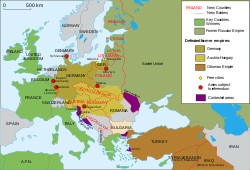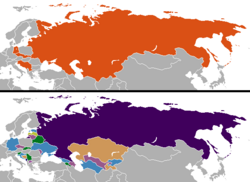This article is missing information about Russia's total maximum expansion.(December 2023) |

The borders of Russia changed through military conquests and by ideological and political unions from the 16th century.
This article is missing information about Russia's total maximum expansion.(December 2023) |

The borders of Russia changed through military conquests and by ideological and political unions from the 16th century.
The formal end to Tatar rule over Russia was the defeat of the Tatars at the Great Stand on the Ugra River in 1480. Ivan III (r. 1462–1505) and Vasili III (r. 1505–1533) had consolidated the centralized Russian state following the annexations of the Novgorod Republic in 1478, Tver in 1485, the Pskov Republic in 1510, Volokolamsk in 1513, Ryazan in 1521, and Novgorod-Seversk in 1522. [1]
After a period of political instability between 1598 and 1613, which became known as the Time of Troubles, the Romanovs came to power in 1613 and the expansion-colonization process of the tsardom continued. While Western Europe colonized the New World, the Tsardom of Russia expanded overland – principally to the east, north and south.
This continued for centuries; by the end of the 19th century, the Russian Empire reached from the Baltic Sea, to the Black Sea, to the Pacific Ocean, and for some time included colonies in the Americas (1732–1867) and an unofficial colony in Africa (1889) in present-day Djibouti [2] that lasted only a month.

The first stage from 1582 to 1650 resulted in North-East expansion from the Urals to the Pacific. Geographical expeditions mapped much of Siberia. The second stage from 1785 to 1830 looked South to the areas between the Black Sea and the Caspian Sea. The key areas were Armenia and Georgia, with some better penetration of the Ottoman Empire, and Persia. By 1829, Russia controlled all of the Caucasus as shown in the Treaty of Adrianople of 1829. The third era, 1850 to 1860, was a brief interlude jumping to the East Coast, annexing the region from the Amur River to Manchuria. The fourth era, 1865 to 1885 incorporated Turkestan, and the northern approaches to India, sparking British fears of a threat to India in the Great Game. [3] [4]
Historian Michael Khodarkovsky describes Tsarist Russia as a "hybrid empire" that combined elements of continental and colonial empires. [5] According to Kazakh scholar Kereihan Amanzholov, Russian colonialism had "no essential difference with the colonialist policies of Britain, France, and other European powers". [6] Qing China defeated Russia in the early Sino-Russian border conflicts, although the Russian Empire later acquired Outer Manchuria in the Amur Annexation through the 1858 Treaty of Aigun from China. [7] During the Boxer Rebellion, the Russian Empire invaded Manchuria in 1900, and the Blagoveshchensk massacre occurred against Chinese residents on the Russian side of the border. [7] Russian Empire reached its maximum territory in Asia with the Russo-Japanese War, where after its defeat, Russia ceded Manchuria, southern Sakhalin, Russian Dalian, and Port Arthur to Japan with the Treaty of Portsmouth, though Russia kept the northern portion of the Chinese Eastern Railway.
Changes in territory to the Tsardom of Russia and Russian Empire, from 1547 to 1905, listed chronologically:
After the October Revolution of November 1917, Poland and Finland became independent from Russia and remained so thereafter. The Russian Empire ceased to exist, and the Russian SFSR, 1917–1991, was established on much of its territory. Its area of effective direct control varied greatly during the Russian Civil War of 1917 to 1922. Eventually the revolutionary Bolshevik government regained control of most of the former Eurasian lands of the Russian Empire, and in 1922 joined the Russian SFSR to Belarus, Transcaucasia, and Ukraine as the four constituent republics of a new state, the Union of Soviet Socialist Republics (USSR), which lasted until December 1991.

Territories of the former Russian Empire that permanently or temporarily became independent:
In 1919, northern Mhlyn, Novozybkiv, Starodub, and Surazh counties (povits) of Ukraine's Chernihiv Governorate were transferred from the Ukrainian SSR to the new Gomel Governorate of the Russian republic. [18] In February 1924, Tahanrih and Shakhtinsky counties (okruhas) were transferred from the Donetsk Governorate of Ukraine to Russia's North Caucasus krai. [19] [20]
By the end of World War II the Soviet Union had annexed:

Of these, Pechenga, Salla, Tuva, Kaliningrad Oblast, the Kurils, and Sakhalin were added to the territory of the RSFSR.
In late 1945, Soviet Russia annexed the northern border strip of the Masurian District (current southern border strip of Kaliningrad Oblast) with the towns of Gierdawy (now Zheleznodorozhny) and Iławka (now Bagrationovsk) from Poland and expelled the already formed local Polish administration. [21]
The Chinese Eastern Railway, formerly a tsarist concession, was taken again by the Soviet Union after the 1929 Sino-Soviet conflict, [22] the railway was returned in 1952. [23]
Meanwhile, territories were removed from the Russian SFSR, including Turkmenistan and Uzbekistan in 1924, Kazakhstan and Kyrgyzstan in 1936, and Karelo-Finland from 1945 to 1956. The Crimean oblast and city of Sevastopol were transferred to Ukraine on 19 February 1954 (later annexed by the Russian Federation in 2014).
There were numerous minor border changes between Soviet republics as well.
After World War II, the Soviet Union set up seven satellite states, in which local politics, military, and foreign and domestic policies were dominated by the Soviet Union: [24]


The dissolution of the Soviet Union has led to the creation of independent post-Soviet states, with the Russian SFSR declaring its independence in December 1991 and changing its name to the Russian Federation.
The Chechen Republic of Ichkeria was a secessionist government of the Chechen Republic during 1991–2000. After Russian defeat at the Battle of Grozny, the First Chechen War ended with Russia recognizing the new Ichkerian government of president Maskhadov in January 1997 and signing a peace treaty in May. But Russia invaded again in 1999, restoring a Chechen Republic and the Ichkeria government was exiled in 2000.
The Russian Federation has been involved in territorial disputes with several its neighbours, including with Japan over the Kuril Islands, with Latvia over the Pytalovsky Raion (settled in 1997), with China over parts of Tarabarov Island and Bolshoy Ussuriysky Island (settled in 2001), with its coastal neighbours over Caspian Sea boundaries, and with Estonia over the adjoining border. Russia also had disputes with Ukraine over the status of the federal city of Sevastopol, but agreed it belonged to Ukraine in the 1997 Russian–Ukrainian Friendship Treaty, and over the uninhabited Tuzla Island, but gave up this claim in the 2003 Treaty on the Sea of Azov and the Kerch Strait.
The Russian Federation has also used its armed forces, armed formations, and material support to help establish the disputed breakaway states of Transnistria in Moldova after the Transnistria War, and South Ossetia and Abkhazia, after the 2008 war in Georgia. In 2008, shortly after announcing the recognition of Abkhazia and South Ossetia, Russian president Dmitry Medvedev laid out a foreign policy challenging the US-dominated "single-pole" world order and claiming a privileged sphere of influence in the near abroad around the Russian Federation and farther abroad. [25] [26] Following these conflicts, both Transnistria and South Ossetia have made proposals for joining Russia.
In 2014, when after months of protests in Ukraine, pro-Russian Ukrainian president Viktor Yanukovych was deposed in the Revolution of Dignity, Russian troops occupied Ukraine's Crimean peninsula, and after a hasty referendum the Kremlin annexed Crimea and Sevastopol. The annexation was not recognized by Ukraine or most other members of the international community. A few weeks later, an armed conflict broke out the Donbas region of Ukraine, in which the Kremlin denies an active role, but is widely considered to be fuelled by soldiers, militants, weapons, and ammunition from the Russian Federation.
On February 21, 2022, the Russian president Putin signed a decree recognizing the independence of two Donbas republics in Ukraine, and invaded the region. Two days later, Russian troops openly invaded Ukrainian-held territory of Ukraine, a move widely seen as an attempt to conduct regime change and occupy much or all of Ukraine. After failing to seize Ukraine's capital Kyiv for over a month, the Russian defence minister stated that the main goal of the war was the "liberation of the Donbas", [27] but later a Russian general stated that it was to seize eastern and southern Ukraine right through to Transnistria, a breakaway territory in Moldova. [28] [29]
On 30 September 2022, Putin announced in a speech [30] that Russia was to annex four partially occupied regions of Ukraine: Donetsk, Kherson, Luhansk, and Zaporizhzhia Oblasts. [31] However, Russia's annexation of these territories was widely condemned by the international community, [32] and Russia does not control the full territory of any of the four annexed regions, and its government was unable to describe the new international "borders". [33]
{{cite book}}: CS1 maint: location missing publisher (link){{cite book}}: CS1 maint: location missing publisher (link){{cite book}}: CS1 maint: location missing publisher (link){{cite book}}: CS1 maint: location missing publisher (link){{cite book}}: CS1 maint: location missing publisher (link){{cite book}}: CS1 maint: location missing publisher (link){{cite book}}: CS1 maint: location missing publisher (link){{cite book}}: CS1 maint: location missing publisher (link){{cite book}}: CS1 maint: location missing publisher (link)